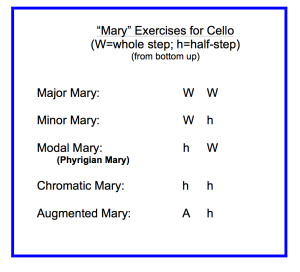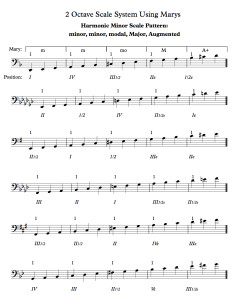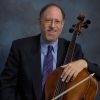
100 Cello Warm-Ups and Exercises Blog 17: Cello Geography Part 3: The “Mary System”
Robert Jesselson
 This blog will be the last one of the year – but we look forward to starting up again in 2016.
This blog will be the last one of the year – but we look forward to starting up again in 2016.
In the first two blogs on Cello Geography we discussed the basic neck positions, and extensions. Next I would like to focus on a tool that I feel is helpful for sorting out one of the most important fingering principles on the cello: the “Mary” System.
For example, in the following passage from the Duport Etude #11, virtually the entire passage is grouped into three-note fingerings:
One of the best ways to practice this kind of fingering pattern is to think of the three-note groups as “Mary Had A Little Lamb”.
These are the basic “Marys” that I just described:
I suggest using this bow-distribution for consistency – and it is a good coordination exercise as well.
Now you can take the Duport passage above and practice it using the Mary system for clarifying the three-note finger patterns that are present throughout the passage:
One can apply this technique using “Marys” to thousands of other passages in our repertoire. I find that it often clarifies the intonation and the finger patterns for my students and myself.
I suggest solidifying this system by applying it to the “universal fingering” two octave scale system (in other words: the same fingering for all scales). In this system we use no open strings and three finger groupings of notes. Below are the two octave major, harmonic and melodic scales using this system. I have indicated the positions (on the bottom) and the type of Marys (on the top). I ask my students to focus their thinking on three things: the names of the notes, the type of Mary in each group, and the positions they are in during multiple repetitions of each scale. And of course they should be thinking about intonation, sound, string crossings, etc, etc as well!
Blog #18 will be on the fabulous thumb! Meanwhile, have happy holidays, and a great New Year.
Subjects: Practicing, Technique









